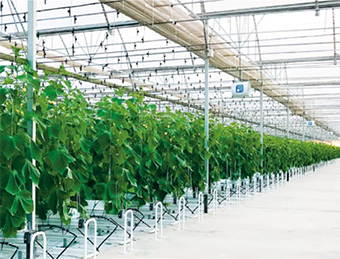
Greenhouses (GH) are structures that help create a controlled environment while also taking advantage of free energy from sunlight and exterior conditions.
There is a whole world of options when you are projecting your greenhouse.
We will give an initial overview of the main factors that differentiate a high tech high performing greenhouse from a lower investment greenhouse:
– Type of Structure,
– Type of Cover
– Type of Climate Control
– Type of Monitoring, Control and Automation
In terms of structures an important factor is the width of the tunnels/bays and the height of the walls.These two factors will define the amount of shading that the structures will create, the free space available per bay and the volume of air to be exchanged/ climatized. Another factor to consider is the type of arch, which will influence the same production variables mentioned above, but that are also conditioned by weather (wind, snow), local legislation (foundations for the arch supports), and type of cover, since not all materials have the same flexibility.
In the matter of Covers there are a variety of options, each with its pros & cons: from the plastic film (polyethylene) to polycarbonate sheets, acrylic , fiberglass or glass among other less usual. There are different innovations inside each of these options and each serve different purposes, maintenance, investment levels and returns on investment.
An Example of a low short term investment is the plastic film cover, which is most used in low height round shaped GH. It can be installed in just one layer or in two layers with an air inflated area in between, and can have different thicknesses but all end up becoming degraded over a 3-5 year period. This is also the least secure type of cover since it’s fairly easy to breach in. They also tend to brittle when ending its life cycle which is a real concern for the local environment if not correctly managed.
Polycarbonate plastic sheets can be used with different amounts of layers and, in our opinion, represent currently one of the best options in terms of value and functionality. They can last at least 10 year with little damage but triple that with the right care, it’s lightweight and has very good properties in terms of light transmission and diffusion and thermal properties. Since it’s a multi-layered material, the extremities must be kept well isolated to avoid dust and algaes and debris in between the layers which will reduce light transmission.
Fiberglass can also be an option and it definitely offers some benefits but it always ends up degrading overtime and reducing the light transmission fairly fast. Acrylic is also an option but their benefits are still behind the polycarbonate sheets in the light transmission diffusivity, thermal properties and resistance to all climate conditions. These cover options represent the medium to higher initial costs but come with better thermal properties,
With the development of different plastics, glass greenhouses are no longer common because of their material weight and consequent structural requirements, their creation of heat spots, their low thermal efficiency and their fragility. It is more usual to see this type of greenhouse in boutique gardens or in north european countries like the Netherlands.
In terms of climate control there are a set of equipment, options and strategies that should be planned for the desired year long conditions and taking into account the local climate, type of crop, volume of air, plant growth stage, light or CO2 supplementation.
There are 3 main categories of greenhouses in regards to climate control:
– Open Greenhouses (currently most common) – where fresh air is brought from outside, pushing the hot humid air out in a passive manner
– Semi-Open Greenhouses (gaining traction, possibly gradually substituting open greenhouses) – Where fresh air is pushed from a controlled space also called climate corridors, and expelled through the zenithal windows.
– Closed Greenhouses (highly specialized greenhouse) – There are no exchanges of air with the exterior and all climate control is done by HVAC and dehumidification.
The open and semi-closed greenhouses allow some savings compared with the closed option. This is due to the fact that, in these scenarios, exchanges with the exterior (direct and indirect respectively) may result in lower climitization needs by using the natural airflow or by pushing/ pulling air with the aid of fans. While closed greenhouses treat all incoming air directly by using an AHU, dehumidifiers and fans which results in minimum variations from the set-points but also higher operational costs.
Some of the equipment options are openings motors, horizontal or vertical fans, nebulizers, shading curtain, heaters, chillers among others.
All these options can only achieve their full potential if they are used correctly. This means that the grower/farmer needs to be aware of the different variables affecting the plant’s growth and which measures might be taken with the existing equipment, to bring the climate back to the desired levels. The key here is that only by knowing the conditions around the plants can the grower take any measures. This means that even with the best structure and cover there will always be variations that affect the plants growth and this can only be tackled with a good monitoring system. A monitoring system must include at least enough sensors to read the temperature and humidity gradients in the various spaces of the greenhouse as well as a meteorological station to measure the exterior conditions in terms of temperature, humidity, wind velocity and direction, rain, irradiance. It is also very important to have CO2 sensors and light sensors (the two main ingredients in photosynthesis).
There are other sensors that might serve as a diagnosis tool or to be used in a research and development stage. Examples are an infrared red temperature sensor to measure leaf temperature or a thermographic camera to measure temperature of the whole canopy, or a substrate humidity meter, or even an airflow meter to look for dead spots, among many others
Sensors should be kept at the ferti-irrigation tanks keeping the EC , pH and Temperature in balance at all times by injecting the different parts of the nutrient solution. Air pumps or mixing blades are also essential to keep the nutrient solution aerated and well mixed . You can also choose to use a dissolved oxygen meter or an ORP meter to assess the level of bacterial activity and organic content of your water.
The monitoring system becomes truly valuable when you join it with a software capable of performing automated decisions everytime the conditions change. There are several levels of automation, from using artificial intelligence to predict the actions to be taken to simply activate a fan when outside conditions are better than indoor. The software saves all data so it is possible to make comparisons between different cultivation methods, allowing you to understand the effects of your decisions and aiding in decision making.
Get in contact with us if you would like further information on greenhouses in general or if you would like to know how to tackle:
- high temperatures
- low temperatures
- high humidity
- low humidity
- low ventilation
